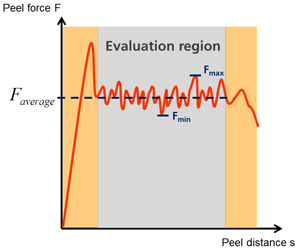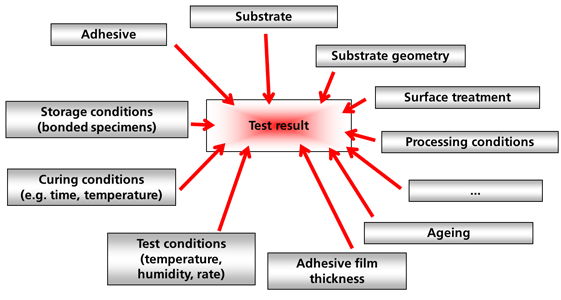6.5.2 Floating roller peel test
Peeling away a thin sheet (flexible substrate) at a constant bend radius: The force acts virtually perpendicular to the bonding are

w: Specimen width (25mm)
l: Specimen length (> 200mm)
lo: Adhesive film length (120mm)
s: Peel distance (> 115mm)
Only suitable for a joint having a combination of a rigid and flexible substrate.
Principles for calculating the peel strength:
Peel diagram

Force profile in the evaluation region → average peel force Faverage

In addition, the maximum and minimum peel strength in the evaluation region must be determined (ps,max, ps,min)
The peel strength ps in kN/m (or N/mm) is the average force per unit specimen width, measured along the bonded joint, which is required to continually separate the two substrates from each other.
- The specimen geometry for the relevant methods is laid down in standards.
- Permissible tolerances are laid down and deviations from the standard geometry (e. g. for plastics) must be documented.
- Surface pretreatment following the instructions of the adhesive manufacturer or according to the appropriate European standard (e. g. ISO 4588).
- At least 5 measurements must be made.
- The specimens must be stored and tested under standard climatic conditions as laid down in ISO 291.
- The test speed of the testing machine is 100 mm/min for the floating roller peel test.
- Recording of the force as a function of the peel distance. In the wedge test the crack size is measured.
Parameters influencing the floating roller peel test
In order to allow comparison of different lap shear test results, the test parameters must be known and documented.
These include in the first instance:
- Substrate material and geometry
- Surface treatment
- Adhesive
- Adhesive film thickness
- Curing temperature and duration
- Test temperature
- Test rate
- For pressure sensitive adhesives, also the relative humidity




